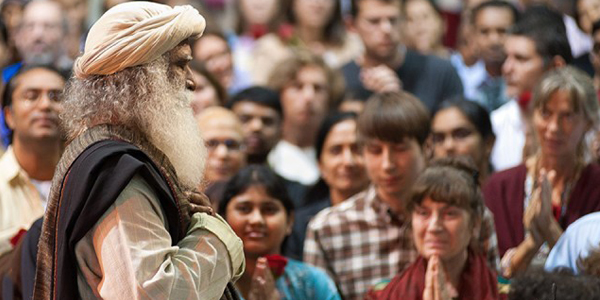Kashi – The City of Light

“The more access you have to another human being, the cleaner you have to be. If “What about me?” is the biggest question in your mind, you should not have access to anyone.”
—Sadhguru
Kashi, or Varanasi as it is commonly known today, was the center of rituals, and a phenomenal tool created for spiritual growth. Yogi and mystic, Sadhguru, looks at the lore and science behind some of its main rituals.
Sadhguru: Mysticism means exploring dimensions that are not yet in your understanding or perception. To explore those dimensions together, there are various types of rituals, which are beautiful, but if not conducted with absolute integrity, they can easily become exploitative. Ritual means not just doing pooja. This used to be a land with complex and phenomenal rituals, but due to lack of integrity and misuse, these rituals largely got wiped out.
For example, Kashi is the oldest living city on the planet. Mark Twain said, “Benares is older than history, older than tradition, older even than legend, and looks twice as old as all of them put together.
Who would have thought someone could plan such a fabulous city 12,000 to 15,000 years ago. It was a most fantastic plan – layers and layers of urban development. The highest level of talent in spirituality, science, mathematics, music, and astronomy all gathered in one place. It became the city of learning and of dispensing knowledge. Shiva enjoyed the intellectual vigor, the music, the company of people, and the way the city was designed. He fell in love with Kashi and did not want to leave anymore.
There is a story of how, when Shiva was about to come to Kashi, king Divodasa did not want him to enter the city because he knew if Shiva was there, he would not be the single point of focus anymore. He said, “A king can rule the city only if everyone looks up to him only. If you want me to rule the city, Shiva should not come. If he comes, I will leave.”
Shiva sent two ganas to the city to see how to get rid of this king. However, they fell so much in love with Kashi that they established themselves just outside the city and never went back. They did not have the guts to go to Shiva and say, “We love the city too much.” Shiva sent two more – they never came back either. Today, at the four corners of Kashi, there are four gana sthanas, where these four guys settled. Then he sent Ganapati – he never came back either. Afterwards, he sent Kubera – he never came back. Finally, he decided to go himself, and he did not want to go back either. All this is being said to tell you how beautiful this city was. When Agastya Muni was asked to leave Kashi and go south, he cried and wrote a heartrending poem, running into hundreds of stanzas, about the beauty of the city and the pain of leaving.
There is a whole lot of science behind how they established certain aspects of the city. It was such a complex and geometrically perfect design. But Kashi is not what it used to be anymore. The superstructure of the city is broken. The center of Kashi was a powerful energy form, which created a tower of light. So many sages and saints have talked about the tower of light, and about the actual Kashi being an energy form above the city. Even today, that part is intact, but the base and the main temple have been broken. But one aspect you must witness if you have the opportunity – in the evening around 7:30, there is one particular ritual, which is called Sapta Rishi Aarti.
After Shiva had transmitted yoga to the Sapta Rishis and they all had become fully enlightened, he sent them to different parts of the world to spread this knowledge. Before they left, they expressed their anguish, “Now if we go away, probably we will never get to set our eyes upon you again, physically. How can we have you with us when we want you?” Shiva taught them a simple process, which lives on to this day as Sapta Rishi Aarti, conducted by these priests who may not know the science behind it, but they stick to the process. I witnessed how they built stacks and stacks of energy, just like that.
We could do this at the ashram but it takes a different kind of skill. There are yogis who do such things – that is a different matter – but I have never seen anything like that anywhere conducted by priests. For priests who have no such energies of their own, what they build up in this temple in this one hour is phenomenal because they have a method – that is what a ritual is. Whoever conducts it, if it is done right, it will work, because it is a technology. These priests maintained the process. They kept well what is of some sanctity to them, and it still works fantastically. And at night, there is the Shayan Aarti, which is cute. If you get to witness it, you will know how loudly you have to put Shiva to sleep.
This is the power of the ritual – you can conduct it for any number of people, even if they are ignorant of it. In contrast, doing anything spiritual, meditative, is in a way safer and cleaner, but you have to prepare the person. A ritual does not need preparation – you can do it for the whole town. It may be a million ignorant people – still, if they just sit there, we can make them benefit. But unless the person who performs the ritual has a certain integrity, rituals become a tool for exploitation.
The best way to approach dimensions of the beyond is through internal methods and processes, but it needs a lot of preparation. If you want a quicker dissemination, there are external technologies and processes – I would rather call them processes than rituals. We can make this happen to large groups of people. But it needs absolute integrity. Only in the last three years, we brought in rituals at the Isha Yoga Center, because we have created people of such integrity that no matter what is given to them, the focus of their lives will not change.
Whatever external activity you do in your life, it is meaningful only if it touches people’s lives. If you can maintain integrity no matter what, we can offer you wonderful tools through which you can touch people’s lives in a way that you have never imagined possible. Once you have such access to another human being, your hands must be super clean. If you are sweeping outside, no one will ask you, “Did you wash your hands?” It is okay if your hands are not so clean. Suppose you are serving food, people would like to know if you washed your hands. Suppose you are inside the temple, we would like to know if you had a shower. Suppose you have to conduct a surgery, we definitely want to know if your hands are cleaned and disinfected.
The more access you have to another human being, the cleaner you have to be. If “What about me?” is the biggest question in your mind, you should not have access to anyone. If this one question does not arise in your mind, you are free to touch any being, and you should. Millions of people need this, because nothing has truly touched them. Without being touched, the being will not be a being – the being will just be a body.


